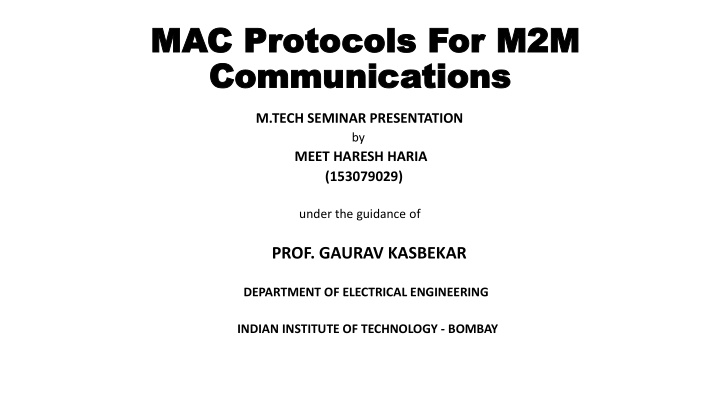



MAC Protocols For M2M Communications M.TECH SEMINAR PRESENTATION by MEET HARESH HARIA (153079029) under the guidance of PROF. GAURAV KASBEKAR DEPARTMENT OF ELECTRICAL ENGINEERING INDIAN INSTITUTE OF TECHNOLOGY - BOMBAY
Introduction • What is M2M? • Why is the Concept of M2M introduced? • Goal of M2M Communication. • Facilities delivered by M2M Communications. • Important Issues in M2M Communications. • MAC layer issues related to in M2M communication.
Requirement of MAC Protocol for M2M Communications • A. Data Throughput And Efficiency • B. Scalability • C. Latency • D. Energy Efficiency • E. Cost Effectiveness • F. Co-existence
General Wireless MAC protocols • A. Contention-Based MAC Protocols. • B. Contention Free MAC Protocols. • C. Hybrid MAC protocols.
Taxonomy of M2M MAC protocols
MAC Protocols Specific to M2M Communications • A. DPCF-M • B. A Scalable Hybrid MAC Protocol for Massive M2M Networks. • C. An Adaptive Multichannel Protocol for Large Scale M2M Networks. • D. Random Access for M2M communications in LTE-Advanced Networks. • E. A Distributed Multichannel MAC Protocol for Multi-Hop Cognitive Radio Networks.
MAC Protocols Specific to M2M Communications • F. Adaptive Load Slotted MACA. • G. Code Expanded Random Access. (CERA) • H. Enhancement of IEEE 802.11ah for M2M Communications.
DPCF-M • 1. Single-RAT and Dual-RAT Devices. • 2. Energy Efficiency. • 3. DPCF-M Communication. • 4. M2M Gateway Selection. • 5. End of Cluster. • 6. Beacon Packet Information.
DPCF-M
A Scalable Hybrid MAC Protocol For Massive M2M Networks.
A Scalable Hybrid MAC Protocol For Massive M2M Networks.
A Scalable Hybrid MAC Protocol For Massive M2M Networks.
An Adaptive Multichannel Protocol For Large Scale M2M Networks. ▪ Multichannel operation – Centralized or Distributed. ▪ Common Control Channel.(CCC Based Protocols). ▪ Dedicate control channel and Split-Phase Multichannel Protocol. • 1) Estimation Phase • 2) Negotiation Phase • 3) Data Transmission phase. • Impact of Tn and p over channel Utilization (U)
An Adaptive Multichannel Protocol For Large Scale M2M Networks.
An Adaptive Multichannel Protocol For Large Scale M2M Networks.
Random Access For M2M Communications in LTE-A Networks. • MTC and H2H perform RA using PRACH. • Base Station Selection. • MTC devices Contend for RBs using RAs with the help of Contention Resolution Method based on a Uniform Back-off Algorithm Scheme. • MTC can connect using Wired or Wireless manner.(LTE-A,Wireless)
Random Access For M2M Communications in LTE-A Networks.
Random Access For M2M Communications in LTE-A Networks.
Random Access For M2M Communications in LTE-A Networks. • Challenges for RA based M2M Communications: 1. PRACH Overload Control. 2. Mode Selection and QoS Provisioning. 3. Efficient Group Management. 4. Opportunistic RA.
Random Access For M2M Communications in LTE-A Networks. • PRACH Overload Control Mechanism: 1. Access Class Barring Scheme. 2. PRACH Resource Separation Scheme. 3. Slotted Access Scheme. 4. Dynamic Allocation of RA Resources. 5. Grouping or Clustering of MTC Devices. 6. MTC-Specific Back-off Scheme. 7. Pull-Based Scheme.
Distributed Multichannel MAC Protocol for Multi-Hop Cognitive Radio Networks. • Spectrum Sensing and Adapting to fill White Holes. • Difficulties: Hidden Terminal Problem. • Solution: Co-operative Spectrum Sensing. • Two types of MACs for CRs : SMAC and MMAC. • Two Types of MMACs : SRV and MRV. • SRV divided in to 3 classes: CCCH, Common Hopping and Split- Phase approach. • Low Power Inaccurate Scan and High Power Accurate Scan. • OR , AND or OPTIMAL FUSION rule.
Distributed Multichannel MAC Protocol for Multi-Hop Cognitive Radio Networks. • Software Defined Radios (SDRs): ➢ Communication and Sensing Done in Parallel. ➢ AFE and DFE. ➢ Fast Sensing and Fine Sensing. • CRs using CCC has advantages: ➢ Reduces Overhead. ➢ Ease of Deployment. ➢ Broadcasting can be done with great efficiency. ➢ Allows Distributed Sensing. • Each CR has two Data Structures: SIP vector and SCL vector.
Code Expanded Random Access (CERA)
Enhancement of IEEE 802.11ah for M2M Communications
Standards For M2M Communications 1. 3GPP 2. ETSI 3. GSMA 4. IEEE 5. Wi-MAX Forum 6. WFA 7. OMA 8. TIA 9. CCSA NITS
Future Research • 1. Growing Network Sizes and Scalability. • 2. Quality of Service Support. • 3. M2M Traffic Characteristics. • 4. Extremely Low Power Operation.
Conclusion
Recommend
More recommend